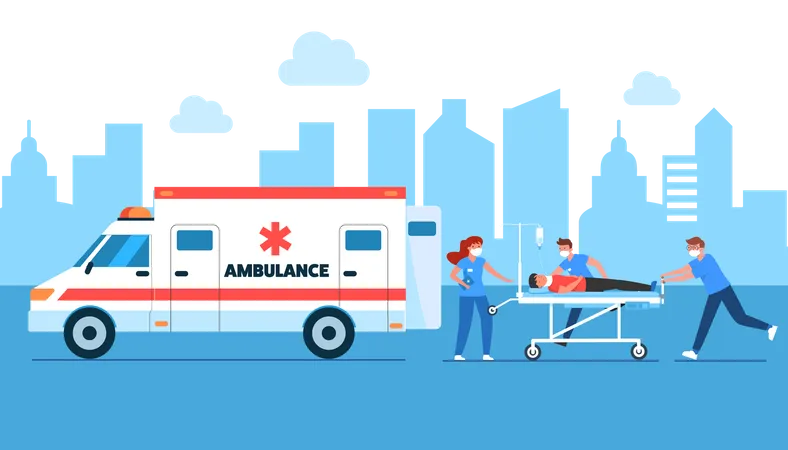Saving Lives at the Tap of a Button: The Impact of Ambulance App Development
Posted 12 months ago by Nilay Chakraborty / 90 views
In a world where technology continues to redefine the way we live, it’s no surprise that even emergency services are undergoing a digital transformation. Ambulance app development is revolutionizing the way we access critical medical assistance during emergencies. Gone are the days of frantic calls to emergency services, uncertain wait times, and inefficient communication. With the tap of a button, individuals can now summon life-saving help directly to their location. In this blog, we’ll explore the profound impact of ambulance app development, how it’s reshaping emergency response systems, and the benefits it brings to both patients and first responders.
The Evolution of Emergency Response
Traditional emergency response systems have long been plagued by challenges such as communication delays, difficulty in pinpointing precise locations, and inefficient allocation of resources. These shortcomings can have dire consequences, especially in time-sensitive medical emergencies where every second counts.
Ambulance app development emerged as a response to these challenges, leveraging the power of mobile technology to streamline the entire emergency response process. These apps provide a user-friendly interface that allows individuals to quickly request assistance, provide vital information about their location and condition, and receive real-time updates on the status of their request.
How Ambulance Apps Work
Ambulance apps operate on a simple yet powerful principle: connecting those in need of emergency medical assistance with the nearest available responders. The process typically involves the following steps:
- User Request: The user launches the ambulance app and submits a request for assistance, providing details about their location and the nature of the emergency.
- Dispatch: The app’s backend system processes the request and dispatches the nearest ambulance or medical responders to the user’s location.
- Real-time Tracking: The user can track the progress of the dispatched vehicle in real-time, receiving updates on estimated arrival time and any relevant instructions.
- Two-way Communication: The app facilitates seamless communication between the user and the responders, allowing for additional information exchange or updates on the patient’s condition.
- Arrival and Assistance: Once the ambulance arrives at the location, responders provide necessary medical assistance, transport the patient to the nearest medical facility if required, and ensure continuity of care.
The Benefits of Ambulance App Development
The impact of ambulance app development extends far beyond mere convenience. Here are some of the key benefits it brings to the table:
- Faster Response Times: By eliminating the need for phone calls and optimizing dispatch processes, ambulance apps significantly reduce response times, ensuring that help reaches those in need as quickly as possible.
- Improved Location Accuracy: Ambulance apps leverage GPS technology to pinpoint the exact location of the user, enabling responders to navigate to the scene with precision, even in unfamiliar areas or remote locations.
- Enhanced Communication: Two-way communication features built into ambulance apps allow users to provide critical information to responders and receive updates on the status of their request, fostering transparency and peace of mind.
- Efficient Resource Allocation: Ambulance app systems intelligently allocate resources based on the urgency and severity of each request, ensuring that available ambulances are deployed where they are needed most.
- Reduced Administrative Burden: Automated data collection and reporting features streamline administrative tasks for emergency services providers, allowing them to focus on delivering high-quality care to patients.
Real-World Examples of Ambulance App Success
The impact of ambulance app development is not just theoretical—it’s making a tangible difference in communities around the world. Let’s take a look at some real-world examples of how these apps are saving lives:
- United States: In cities like New York and San Francisco, ambulance apps have become an integral part of the emergency response infrastructure, helping to reduce response times and improve outcomes for patients experiencing medical emergencies.
- India: Ambulance apps have gained popularity in densely populated urban areas like Delhi and Mumbai, where traffic congestion can pose significant challenges for traditional emergency services. These apps help navigate through traffic more efficiently, ensuring timely assistance for those in need.
- Europe: Countries like the United Kingdom and Germany have embraced ambulance app technology as a means of modernizing their healthcare systems and providing more accessible emergency services to their citizens.
Challenges and Future Directions
While ambulance app development has made great strides in improving emergency response systems, challenges remain. Issues such as network connectivity issues, user adoption barriers, and regulatory compliance requirements need to be addressed to ensure the continued success and scalability of these apps.
Looking ahead, the future of ambulance app development holds immense promise. Advancements in artificial intelligence, machine learning, and IoT (Internet of Things) technology are poised to further enhance the capabilities of these apps, enabling more personalized and efficient emergency medical care.
Conclusion
Ambulance app development is transforming the way we think about emergency response. By harnessing the power of mobile technology, these apps are saving lives, reducing response times, and improving outcomes for patients in need. As technology continues to evolve, we can expect ambulance apps to play an increasingly crucial role in modernizing emergency services and ensuring that help is always just a tap away.
- Listing ID: 19166
- Country: USA
- City: Noida

